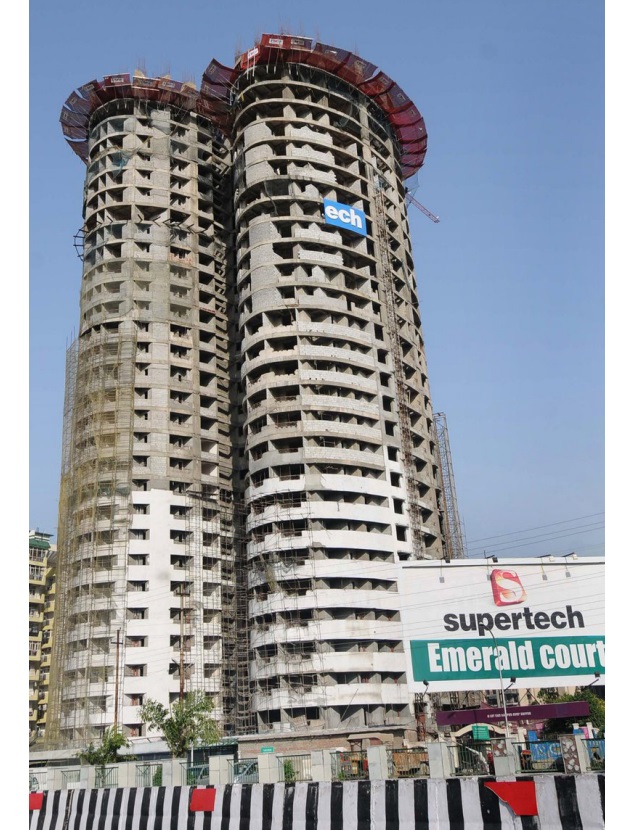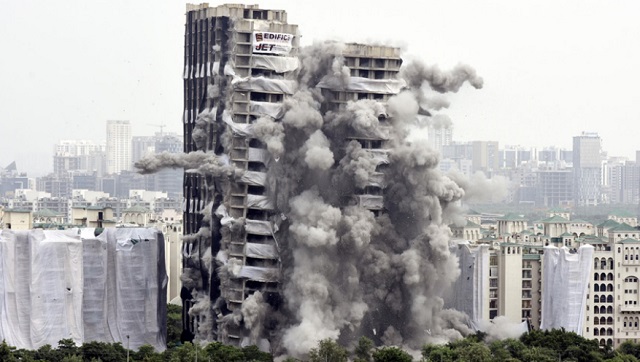
Twin high towers demolished in lesson to offenders
| THE INDEPENDENT | The demolition of Supertech’s twin towers; Apex and Ceyane near the capital Delhi should be a lesson for all stakeholders in the real estate industry in India that accountability will be enforced if they violate building laws, according to industry leaders.
The Supertech’s twin towers; Apex and Ceyane were safely demolished on Aug.28, a year after the Supreme Court had ordered their razing for “construction in violation of norms”. They were demolished by the builder company at its own expense under the guidance of the Noida Authority.
“This decision is symbolic of the New India that we are living in, which is all about best practices, governance and following the law. We stand by the authorities and Supreme Court in this decision,” Confederation of Real Estate Developers Associations of India (CREDAI) national President Harsh Vardhan Patodia told journalists.
When the ‘Supertech Emerald Court’ housing society was originally permitted, the building plan showed 14 towers of nine storyeys.
But the twin towers had 32 storeys (Apex) and 29 storeys (Ceyane) with a height of 103 metres each, according to officials. The plan original plan had been revised and the builder was allowed to construct 40 floors in each tower.
Following this, residents of Supertech Emerald Court society went to the Allahabad High Court in 2012 stating that the construction was illegal. The petitioners argued that the Supertech group violated norms to sell more flats and enhance their profit margins. Also, the area where the additional towers were illegally built was supposed to be made into a garden as per the original plan.
Accordingly, in 2014, the court directed the authority to demolish the towers within four months. But the case went to the Supreme Court.
Last August, the Supreme Court also ordered the towers be demolished – in three months, but it’s taken a year due to technical difficulties. The Supreme Court observed that building norms were violated by the builder in collusion with authorities.
The state regulatory authorities under the Real Estate (Regulation and Development) Act, 2016 (RERA) should be more empowered to take action against defaulters and protect consumers interest, according to industry leaders.
The Real Estate (Regulation and Development) Act aims to protect the homebuyers. The RERA Act ensures quality production, timely delivery, balanced agreements, transparency on sale based on carpet area and transparency on utlisation, among other benefits. The first step for any homebuyer in India should be to check if the housing project is RERA-registered or not.
‘Need to avoid any violations’
When contacted, leading property consultant Anuj Puri said: “It’s a lesson for all stakeholders concerned. The apex court has confirmed that if there are any violations, accountability will be fixed and going forward stakeholders will need to avoid any violations and remain within the purview of law.”
Shishir Baijal, chairman and managing director, Knight Frank India, said it is a strong statement towards making real estate a transparent and responsible business segment.
“We feel that developers and buyers will take cautionary notes and ensure that their projects are free of ambiguity and have all necessary clearances,” he said.
RERA enactment
Colliers India CEO Ramesh Nair said the state RERA authorities have a huge role to play to enforce the guidelines to enhance transparency, protect homebuyers’ rights and prevent wrongdoing.
Vishal Raheja, founder and MD of property consulting firm InvestoXpert, said following the demolition, developers will be more conscious of taking decisions related to change in FAR (floor area ratio). “This is also a crucial lesson to all the developers to take decisions mindfully and bar themselves from doing illegal construction in future,” he added.
After the enactment of RERA in India, Raheja said processes have become crystal clear and customers are able to access all technical information about projects on the RERA website. The Delhi-NCR property market, one of the biggest in India, has been impacted severely over the last one decade because of defaults by developers in completion of real estate projects.
Jaypee Infratech, Unitech, Amrapali and The 3C Company are some of the big companies whose projects are stalled in Delhi-NCR. There are many other builders who have defaulted on their promises to deliver their projects on time to customers, who have already paid almost the entire purchase price and are also paying interest on home loans.
Homebuyers have approached various courts as well as the National Company Law Tribunal (NCLT) against the defaulting builders.

Challenging process
The illegal towers were demolished by waterfall implosion technique in a matter of 12 seconds. Mumbai-based Edifice Engineering, with Jet Demolitions of South Africa as its expert partner for the job.
Jet Demolitions holds a distinguished position globally for demolition works. In November 2019, the firm had grounded the 108-metre-tall Bank of Lisbon building in Johannesburg within a few seconds in an eye-popping event and ensured that a structure barely seven metres next to it was safe too.
With the successful demolition of the Supertech twin towers here on Sunday, India has joined the club of countries that have razed buildings taller than 100 metres, said Joe Brinkman of Jet Demolitions said.
Brinkman said the team’s first priority was to ensure that there were no injuries to people during the implosion and no structural damages caused to any of the buildings around.
He added that very few buildings taller than 100 metres have been demolished in a controlled manner across the world.
Edifice Engineering partner Utkarsh Mehta said around 35,000 cubic metres or approximately 80,000 tonnes of debris was left after the demolition.
Around 50,000 tonnes of it has been absorbed in the basements of the now-demolished towers while the remaining would be disposed of in 90 days, he said.
Jigar Chheda, another Edifice partner, said they took a full six months to plan the clean execution of the demolition and the whole exercise was a “very challenging” process.
“Days and nights went into the preparation for this day. Over 9,000 holes were drilled for explosives in the two buildings; they had to be most accurate and all this was challenging,” Chheda told journalists.
“Getting permission from all authorities concerned, coordinating with multiple agencies, and convincing residents of safety were key effort areas,” he said.
Mayur Mehta, project manager for Edifice, said 9,642 holes were drilled and 3,700 kgs of explosive were used for the demolition.
“The types of explosives used were Solar coal – with 6 gm, 10 gm, 20 gm, and 80 gm mass. Electric detonators, shock tubes and emulsions were also used. The tubes were placed in a way that some had a 0.5-millisecond explosion capacity, while others had a 7,000-millisecond capacity,” he added.
Edifice officials said nine metres of the boundary wall of ATS Village comprising some 900 bricks was damaged.
Several window panes in Emerald Court as well as ATS Village were cracked and they had started the process to replace them with new ones shortly after inspection at the site.
The Indian government announced in July that in Delhi alone 64,300 illegal or unauthorised constructions had been identified since 2016 by various agencies. Also, 29,986 illegal or unauthorised constructions had been demolished or stopped in Delhi since 2016.
****
 The Independent Uganda: You get the Truth we Pay the Price
The Independent Uganda: You get the Truth we Pay the Price



